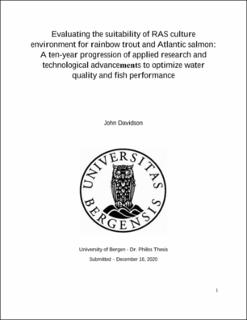| dc.contributor.author | Davidson, John | |
| dc.date.accessioned | 2021-10-25T12:38:18Z | |
| dc.date.available | 2021-10-25T12:38:18Z | |
| dc.date.issued | 2020 | |
| dc.identifier.uri | https://hdl.handle.net/11250/2825402 | |
| dc.description.abstract | Over the last several decades, recirculating aquaculture systems (RAS) have become a viable technology for the production of high-value food-fish. In Norway, for example, many Atlantic salmon smolt farms are now using RAS, and there is increased interest and investment in landbased facilities for the production of larger smolts, post-smolts, and, in some cases, market-size Atlantic salmon. Similar trends are taking shape in other countries, including the United States where multi-million-dollar land-based salmon and trout facilities are being planned and constructed with several already in operation.
RAS continuously recycle water through specialized unit processes that recondition the flow to support intensive fish production. Core advantages of RAS include substantial water savings, diminished waste discharge, and increased flexibility for siting facilities near major seafood markets; however, a critical tradeoff is the accumulation of dissolved nutrients, metals, and compounds that can negatively affect fish health and performance in the absence of proper water treatment and system management techniques. Therefore, research that prioritizes assessment of technologies and operational metrics that optimize the RAS environment has been and will continue to be essential for sustainable industry growth.
During my 21-year career as a researcher at The Conservation Fund’s Freshwater Institute, I have focused largely on evaluating the suitability of environmental conditions for salmonid production in RAS. Early research sought to identify accumulating water quality variables of concern, followed by studies designed to establish safe water quality thresholds for salmonids, namely nitrate. Assessment of specialized technologies for water quality control was intertwined with these objectives and is now at the forefront of today’s research. As the use of RAS for intensive salmonid production is still a relatively new frontier, novel questions continue to arise and evolve with increasing RAS scale, adoption of new technologies, and the declining availability of clean water resources.
My thesis will track the evolution of research that I have contributed to as author and researcher within the focal area of RAS culture environment with special attention to seven peer-reviewed articles. Each manuscript resulted in novel information regarding the RAS environment for salmonids while raising new questions and providing direction for important follow-up studies. This manuscript provides a history of related research, concluding with up-to-date studies that blend optimization of the RAS culture environment with use of advanced water treatment technologies such as ozone and membrane biological reactor systems. My research synopsis will also focus on the relevance and practicality of these studies to the salmonid aquaculture industry, particularly in the United States, and seeks to extract additional value when considering the results with broader perspective related to water use and technology selection for commercial scale operations. | en_US |
| dc.language.iso | eng | en_US |
| dc.publisher | The University of Bergen | en_US |
| dc.relation.haspart | Paper 1: Davidson, J., Good, C., Welsh, C., Summerfelt, S., 2011a. Abnormal swimming behavior and increased deformities in rainbow trout Oncorhynchus mykiss cultured in low exchange recirculating aquaculture systems. Aquacultural Engineering 45, 109-117. The article is available in the thesis. The article is also available at: <a href="https://doi.org/10.1016/j.aquaeng.2011.08.005" target="blank">https://doi.org/10.1016/j.aquaeng.2011.08.005</a> | en_US |
| dc.relation.haspart | Paper 2: Davidson, J., Good, C., Welsh, C., Summerfelt, S., 2011b. The effects of ozone and water exchange rates on water quality and rainbow trout Oncorhynchus mykiss performance in replicated water recirculating systems. Aquacultural Engineering 44, 80-96. The article is available in the thesis. The article is also available at: <a href="https://doi.org/10.1016/j.aquaeng.2011.04.001" target="blank">https://doi.org/10.1016/j.aquaeng.2011.04.001</a> | en_US |
| dc.relation.haspart | Paper 3: Davidson, J., Good, C., Welsh, C., Summerfelt, S., 2014. Comparing the effects of high vs. low nitrate on the health, performance, and welfare of juvenile rainbow trout Oncorhynchus mykiss within water recirculating aquaculture systems. Aquacultural Engineering 59, 30-40. The article is available in the thesis. The article is also available at: <a href="https://doi.org/10.1016/j.aquaeng.2014.01.003" target="blank">https://doi.org/10.1016/j.aquaeng.2014.01.003</a> | en_US |
| dc.relation.haspart | Paper 4: Davidson, J., Good, C., Russell, C., Summerfelt, S.T., 2017. Evaluating the chronic effects of nitrate on the health and performance of post-smolt Atlantic salmon Salmo salar in freshwater recirculation aquaculture systems. Aquacultural Engineering 79, 1-8. The article is available in the thesis. The article is also available at: <a href="https://doi.org/10.1016/j.aquaeng.2017.08.003" target="blank">https://doi.org/10.1016/j.aquaeng.2017.08.003</a> | en_US |
| dc.relation.haspart | Paper 5: Davidson, J., Summerfelt, S., Straus, D., Good, C., 2019a. Evaluating the effects of prolonged peracetic acid dosing on water quality and rainbow trout Oncorhynchus mykiss performance in recirculation aquaculture systems. Aquacultural Engineering 84, 117-127. The article is available in the thesis. The article is also available at: <a href="https://doi.org/10.1016/j.aquaeng.2018.12.009" target="blank">https://doi.org/10.1016/j.aquaeng.2018.12.009</a> | en_US |
| dc.relation.haspart | Paper 6: Davidson, J., Summerfelt, S., Vinci, B., Schrader, K., Good, C., 2019b. Integrating activated sludge membrane biological reactors with freshwater RAS: Preliminary evaluation of water use, water quality, and rainbow trout Oncorhynchus mykiss performance. Aquacultural Engineering 87, 102022. The article is available in the thesis. The article is also available at: <a href="https://doi.org/10.1016/j.aquaeng.2019.102022" target="blank">https://doi.org/10.1016/j.aquaeng.2019.102022</a> | en_US |
| dc.relation.haspart | Paper 7: Davidson, J., Summerfelt, S., Espmark, A.M.O., Mota, V., Marancik, D., Early, R., Snead, A. Good, C. 2021. Effects of ozone on post-smolt Atlantic salmon Salmo salar performance, health, and maturation in freshwater recirculation aquaculture systems. Aquaculture 533, 736208. The article is available in the thesis. The article is also available at: <a href="https://doi.org/10.1016/j.aquaculture.2020.736208" target="blank">https://doi.org/10.1016/j.aquaculture.2020.736208</a> | en_US |
| dc.rights | Navngivelse-Ikkekommersiell 4.0 Internasjonal. This item's rights statement or license does not apply to the included articles in the thesis. | * |
| dc.rights.uri | http://creativecommons.org/licenses/by-nc/4.0/deed.no | * |
| dc.title | Evaluating the suitability of RAS culture environment for rainbow trout and Atlantic salmon: A ten-year progression of applied research and technological advancements to optimize water quality and fish performance | en_US |
| dc.type | Doctoral thesis | en_US |
| dc.rights.holder | Copyright the author | en_US |

